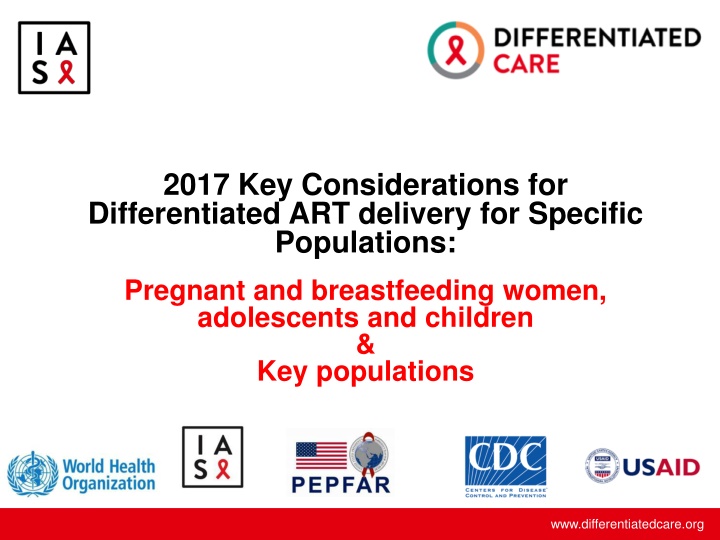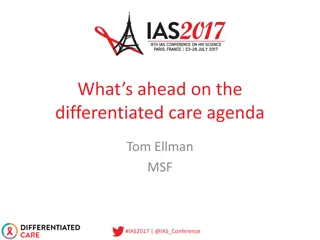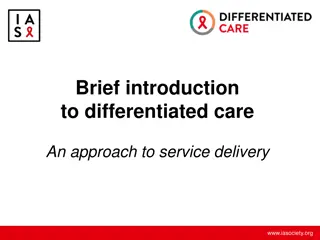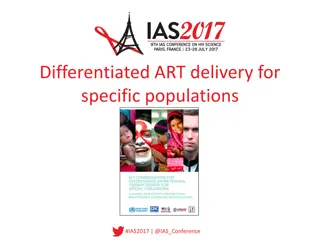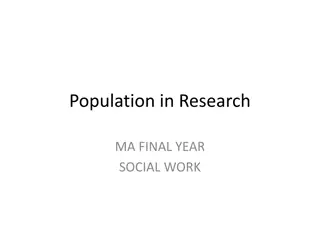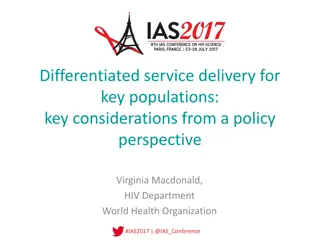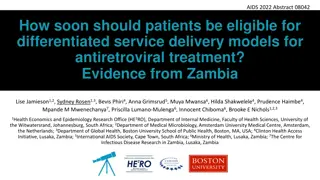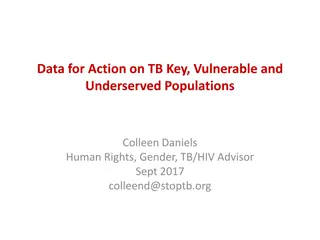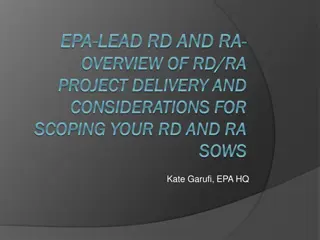Key Considerations for Differentiated ART Delivery for Specific Populations
This collection of resources discusses key factors in differentiated approaches to HIV care, focusing on pregnant and breastfeeding women, adolescents, children, and key populations such as people who inject drugs, sex workers, men who have sex with men, transgender individuals, and those in prisons. It emphasizes criteria for clinically stable clients, building blocks for ART refill and clinical consultation, and referral for intensified care within these populations. The guidelines also define stable clients within different subgroups and highlight the importance of maintaining access to care and support services.
Download Presentation

Please find below an Image/Link to download the presentation.
The content on the website is provided AS IS for your information and personal use only. It may not be sold, licensed, or shared on other websites without obtaining consent from the author.If you encounter any issues during the download, it is possible that the publisher has removed the file from their server.
You are allowed to download the files provided on this website for personal or commercial use, subject to the condition that they are used lawfully. All files are the property of their respective owners.
The content on the website is provided AS IS for your information and personal use only. It may not be sold, licensed, or shared on other websites without obtaining consent from the author.
E N D
Presentation Transcript
2017 Key Considerations for Differentiated ART delivery for Specific Populations: Pregnant and breastfeeding women, adolescents and children & Key populations www.differentiatedcare.org
Not just what and when to start BUT HOW www.differentiatedcare.org
2016 Guidelines Identified diversity of care needs for PLHIV Focused on adult clients www.differentiatedcare.org
Key factors in differentiated approaches to HIV care www.differentiatedcare.org
2017 Key Considerations Supports differentiated ART delivery for: Pregnant and breastfeeding women, adolescents and children Key populations including (1) people who inject drugs, (2) sex workers, (3) men who have sex with men, (4) transgender people and (5) people in prisons and closed settings. Considers for each of these populations: Criteria for clinically stable clients Building blocks for ART refill, clinical consultation & psychosocial support visits Referral for intensified care www.differentiatedcare.org
Definition of stable client + Same as adult Children: Older than two years + same regimen for >3 months + disclosure process orientation with caregivers. Adolescents: Access to psychosocial support established Women clinically stable on ART when conceiving:Already accessing differentiated ART delivery model + one viral load test of <1000 copies/mL in past three months + accessing antenatal care. Women initiating ART during pregnancy:Only eligible for differentiated ART in the postpartum period + HIV-negative PCR result for six-week-old infants + evidence accessing infant follow-up care. Drug use or drug dependence, including alcohol:Clinician assessment of safety of reduced clinical care and support. www.differentiatedcare.org
Mid-level health workers can undertake routine clinical consultations with doctors engaged in complicated cases www.differentiatedcare.org
For children, adolescents and pregnant & breastfeeding women: For key populations: ART refills Clinical consultations Psychosocial support HIV prevention and harm reduction Mental health assessment Drug and alcohol screening HIV prevention, including harm reduction, sexually transmitted infections, viral hepatitis and TB services either on site or through referral Check need for legal advice Addressing violence and provide HIV prevention, including harm reduction Support after release from prisons www.differentiatedcare.org
Referral criteria for intensified care www.differentiatedcare.org
